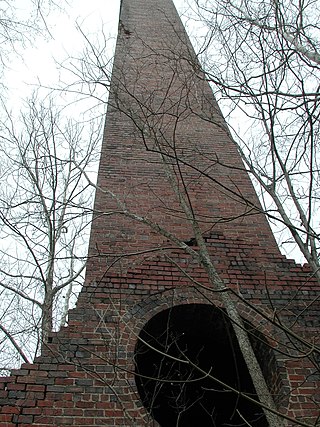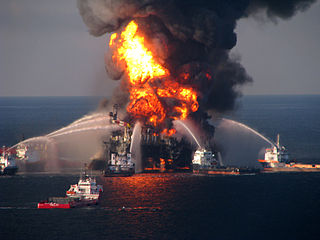
Bearcreek is an incorporated town in Carbon County, Montana, United States. It is part of the Billings, Montana Metropolitan Statistical Area. The population was 91 at the 2020 census. Bearcreek uses the Mayor/Council form of government.

Red Lodge is a city and county seat of Carbon County, Montana, United States. As of the 2020 census, the population of the city was 2,257.
Firedamp is any flammable gas found in coal mines, typically coalbed methane. It is particularly found in areas where the coal is bituminous. The gas accumulates in pockets in the coal and adjacent strata and when they are penetrated the release can trigger explosions. Historically, if such a pocket was highly pressurized, it was termed a "bag of foulness".
A mining accident is an accident that occurs during the process of mining minerals or metals. Thousands of miners die from mining accidents each year, especially from underground coal mining, although accidents also occur in hard rock mining. Coal mining is considered much more hazardous than hard rock mining due to flat-lying rock strata, generally incompetent rock, the presence of methane gas, and coal dust. Most of the deaths these days occur in developing countries, and rural parts of developed countries where safety measures are not practiced as fully. A mining disaster is an incident where there are five or more fatalities.

The Millfield Mine disaster occurred November 5, 1930, at the Sunday Creek Coal Company Poston Mine Number 6 in Dover Township, Athens County, Ohio. It was the state's worst mine disaster, killing 82 men. Sigmund Kozma was the last remaining survivor of the disaster, passing away on January 3, 2009.

The Monongah mining disaster of Monongah, West Virginia occurred on December 6, 1907, and has been described as "the worst mining disaster in American history." 362 miners were killed. The explosion occurred in Fairmont Coal Company’s No. 6 and No. 8 mines, and was one of the contributing events leading to the creation of the United States Bureau of Mines.

The Oaks explosion, which happened at a coal mine in West Riding of Yorkshire on 12 December 1866, remains the worst mining disaster in England. A series of explosions caused by firedamp ripped through the underground workings at the Oaks Colliery at Hoyle Mill near Stairfoot in Barnsley killing 361 miners and rescuers. It was the worst mining disaster in the United Kingdom until the 1913 Senghenydd explosion in Wales.
An asphyxiant gas, also known as a simple asphyxiant, is a nontoxic or minimally toxic gas which reduces or displaces the normal oxygen concentration in breathing air. Breathing of oxygen-depleted air can lead to death by asphyxiation (suffocation). Because asphyxiant gases are relatively inert and odorless, their presence in high concentration may not be noticed, except in the case of carbon dioxide (hypercapnia).
The Castle Gate mine disaster occurred on March 8, 1924, in a coal mine near the town of Castle Gate, Utah, located approximately 90 miles southeast of Salt Lake City. All of the 171 men working in the mine were killed in the series of three violent explosions. One worker, the leader of the rescue crew, died from carbon monoxide inhalation while attempting to reach the victims shortly after the explosion.

The Ulyanovskaya Mine disaster was caused by a methane explosion that occurred on March 19, 2007 in the Ulyanovskaya longwall coal mine in the Kemerovo Oblast. At least 108 people were reported to have been killed by the blast, which occurred at a depth of about 270 meters (885 feet) at 10:19 local time. The mine disaster was Russia's deadliest in more than a decade.

Zasyadko Mine is a coal mining company in Ukraine's eastern city of Donetsk. Following the start of the War in Donbass in 2014 the mine became situated in rebel controlled territory.
The Minnie Pit disaster was a coal mining accident that took place on 12 January 1918 in Halmer End, Staffordshire, in which 155 men and boys died. The disaster, which was caused by an explosion due to firedamp, is the worst ever recorded in the North Staffordshire Coalfield. An official investigation never established what caused the ignition of flammable gases in the pit.
Two separate explosions in 1903 and 1908 at Hanna Mines, coal mines located in Carbon County, Wyoming, United States, caused a total of over 200 fatalities. The 1903 incident was Wyoming's worst coal mining disaster.

Energy resources bring with them great social and economic promise, providing financial growth for communities and energy services for local economies. However, the infrastructure which delivers energy services can break down in an energy accident, sometimes causing considerable damage. Energy fatalities can occur, and with many systems deaths will happen often, even when the systems are working as intended.
Washoe is a settlement in Carbon County, Montana, United States, situated at the foot of the Beartooth Mountains. It is situated on Montana Secondary Highway 308.
The Harwick Mine disaster was a mining accident on January 25, 1904 in Cheswick, Pennsylvania, some sixteen mi (26 km) north of Pittsburgh in the western part of the state. The blast killed an estimated 179 miners and 2 aid workers. The disaster ranks among the ten worst coal mining disasters in American history. One community especially impacted was the Hungarian community in Homestead, Pennsylvania. Fifty-eight of the members of the First Hungarian Reformed Church of Homestead—a full third of the congregation—died in the explosion.

The Mather Mine disaster refers to the events surrounding an explosion that occurred in the Mather Mine on May 19, 1928 at 4:07 PM in Mather, Pennsylvania. A report released by the United States Bureau of Mines states that a total of 195 men were killed in the catastrophe, of which two died in hospitals after being discovered by rescue crews and volunteers. The Mather Mine disaster ranks as the seventh worst mining disaster in U.S. history and the second worst in Pennsylvania history.

Mine safety is a broad term referring to the practice of controlling and managing a wide range of hazards associated with the life cycle of mining-related activities. Mine safety practice involves the implementation of recognised hazard controls and/or reduction of risks associated with mining activities to legally, socially and morally acceptable levels. While the fundamental principle of mine safety is to remove health and safety risks to mine workers, mining safety practice may also focus on the reduction of risks to plant (machinery) together with the structure and orebody of the mine.

In February 2016, a series of explosions caused the deaths of 36 people, including 31 miners and five rescue workers, at the Severnaya coal mine 10 kilometres north of the city of Vorkuta, Komi Republic, Russia. The explosions were believed to be caused by ignition of leaking methane gas. It is the second deadliest mining disaster of the 2010s behind the Soma mine disaster, and fourth deadliest of the 21st century thus far.













